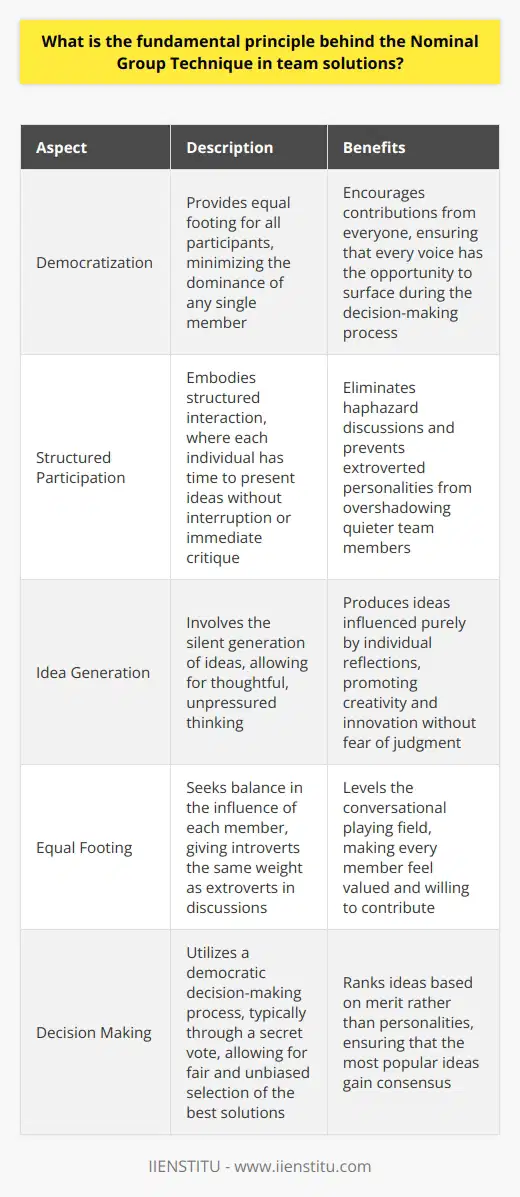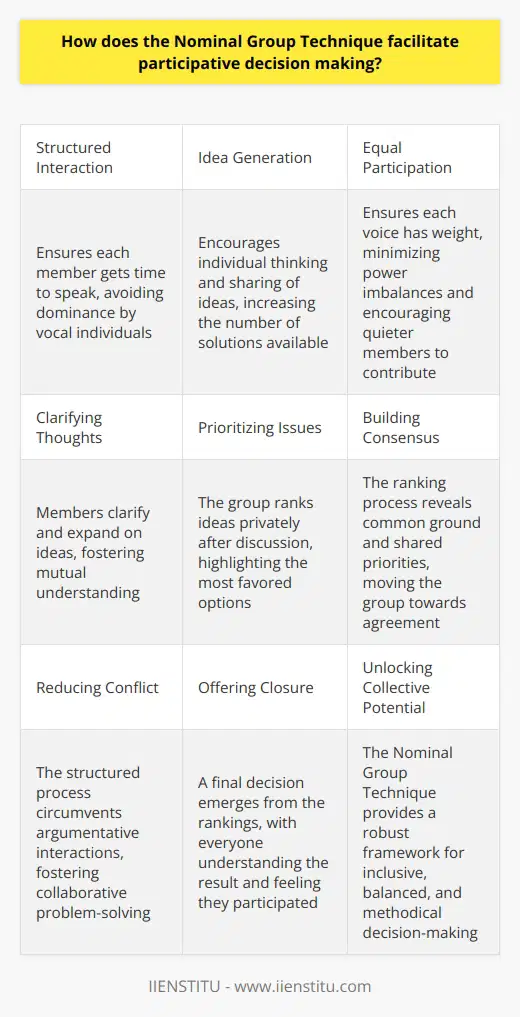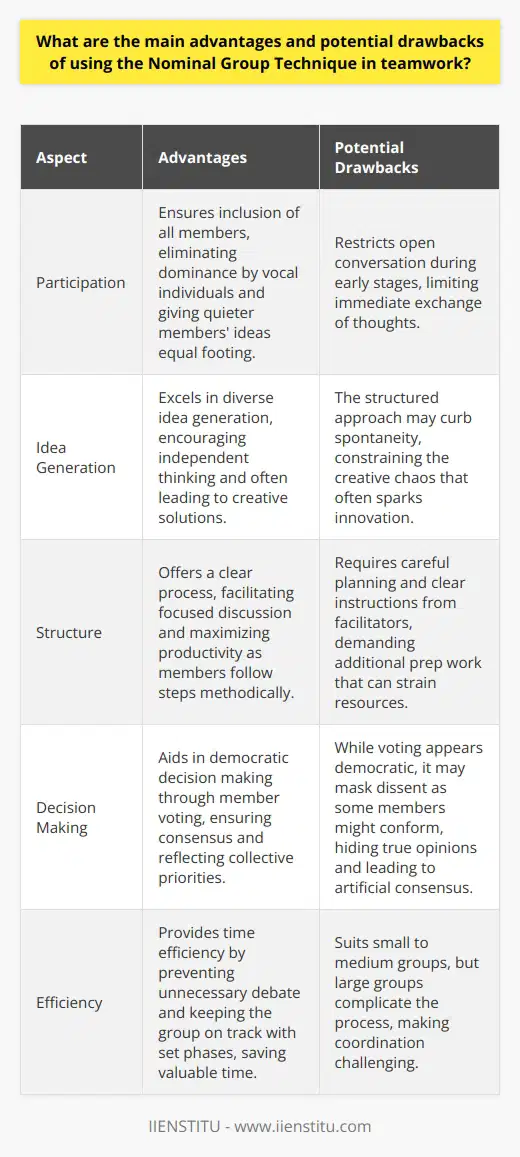
In today’s fast-paced business environment, the significance of effective team solutions in a collaborative setting cannot be overstated. With the necessity for swift decision-making and innovative problem resolution, harnessing the collective intelligence of a group has become paramount. An increasingly popular methodology for drawing out group wisdom is the Nominal Group Technique (NGT), which stands alone as a powerful tool amongst an array of team collaboration techniques.
This article will elucidate the role of NGT in fostering robust group decisions and buttressing the problem-solving techniques that are crucial for any team’s success. For professionals and teams eager to refine their collaborative capabilities, understanding and applying NGT can be an advancement akin to completing a problem solving skills course or an online MBA course.
Understanding the Nominal Group Technique
Definition and Origins of NGT as a Productivity Tool
The Nominal Group Technique is a structured methodology originated in the 1960s by Andre Delbecq and Andrew H. Van de Ven, principally to ameliorate the effectiveness of group decision-making processes. It is predicated on the belief that individuals working together in a methodical manner can outperform the sum of their solitary problem-solving efforts.
NGT serves as a productivity tool by minimizing the common problems in group activities, such as the suppression of ideas and the unequal participation among members.
Comparison with Other Team Collaboration Techniques
While there are myriad techniques for team collaboration, NGT stands out due to its unique blend of individual and group activities. Unlike open discussions, where the loudest or most dominant voices may prevail, or brainstorming sessions that can suffer from a lack of focus, NGT provides a democratic platform ensuring each member’s voice is heard and respected.
The Mechanics of NGT: Steps and Procedures
The success of NGT lies in its structured approach which encompasses several key steps:
Silent Generation of Ideas: Team members individually jot down their ideas in silence, which serves to prevent bias or influence from others.
Round-robin sharing of Ideas: Participants take turns to share their ideas one at a time, ensuring that all voices are heard without interruption.
Group Discussion for Clarification: There is an opportunity for clarification to ensure that all ideas are thoroughly understood, without critique or debate at this juncture.
Independent Voting for Idea Ranking: Finally, each member independently votes on the ideas, typically ranking them, to objectively determine the group's preferences.
Advantages of Implementing NGT in Problem Solving
Inclusivity within the Team and Equal Participation
NGT is highly inclusive, ensuring that each team member has an equal opportunity to contribute. This can be particularly valuable in diverse teams, where members vary in their level of outspokenness or in cultural backgrounds that might otherwise influence participation.
Reduction of Dominant Personality Influence
One of the most salient benefits of NGT is its ability to dilute the sway of dominant personalities. By allowing all members to contribute without fear of immediate judgment, the technique promotes a broad range of ideas and democratizes the problem-solving process.
Encouragement of Idea Diversity and Creativity
NGT encourages creativity through its initial individual ideation phase, allowing for a varied set of solutions that might not surface in a typical group setting. This diversity in ideas can lead to novel solutions and an amplification of the team’s creative potential.
Real-World Applications of NGT
Case Studies Illustrating the Use of NGT in Various Industries
NGT has been successfully implemented in an array of contexts from healthcare for enhancing patient care processes to engineering for brainstorming design solutions. Each case study reinforces NGT's adaptability and effectiveness across different sectors.
NGT’s Role in Strategic Planning and Product Development
Especially in strategic planning and product development, NGT has proven to be invaluable. It helps align team members toward a common goal, ensuring that the final decisions are reflective of collective wisdom and insights.
Examples of NGT Resolving Team Conflicts
Conflicts often arise from misunderstandings or the clash of ideas in team settings. NGT, through its structured and equalizing framework, allows for the diffusion of conflicts by ensuring each member’s perspective is understood and considered systematically.
Best Practices for Facilitating an NGT Session
Preparing for an NGT Session: Setting Objectives and Choosing Participants
Planning is crucial for a successful NGT session. Clearly defined objectives must be set, and a representative cross-section of participants needs to be chosen to garner diverse perspectives.
The Role of the Facilitator in Guiding the NGT Process
The facilitator's role is pivotal in steering the NGT process, from the silent idea generation to the final voting. They must be adept at maintaining the structure and flow of the session while ensuring inclusivity.
Addressing Challenges: Ensuring Effective Participation and Managing Time Constraints
Facilitators should be skilled at encouraging participation from all attendees and managing sessions efficiently to stick to time constraints. This preserves the momentum and focus necessary for productive outcomes.
Integrating NGT with Other Productivity Tools and Techniques
How NGT Complements Agile Methodologies and Design Thinking
NGT can seamlessly blend with agile methodologies and design thinking by enhancing the iterative process of idea generation and refinement. It adds structure to the open-ended realms these methodologies often operate in.
Using Technology to Facilitate NGT in Virtual Teams
In a world where virtual teams are commonplace, technology can be leveraged to conduct NGT sessions effectively through video conferencing tools and online collaboration platforms.
Linking NGT Outcomes with Project Management Tools for Execution
The outcomes of an NGT session should be translated effectively into actionable tasks, often utilizing project management tools. This ensures that the decision-making process has tangible results.
As organizations continually search for methods to unlock team solutions, the Nominal Group Technique stands as a beacon of structured, democratic, and effective decision-making. Its advantages underscore its versatility and the capacity for engendering robust group decisions and enhancing problem-solving. Incorporating NGT within team settings goes beyond a mere procedural adoption; it fosters a culture of collaboration, inclusion, and innovation. This technique, synonymous with the valuable insights gained from an online MBA course or a specialized problem solving skills course, can significantly elevate a team’s problem-solving arsenal. Therefore, teams aiming for excellence should consider the Nominal Group Technique not simply as a tool but as an essential component within their collaborative framework.
References
This section would list relevant academic references and resources for further reading on the Nominal Group Technique and team collaboration techniques for those wishing to delve deeper into the subject matter.
Frequently Asked Questions
What is the fundamental principle behind the Nominal Group Technique in team solutions?
Understanding Nominal Group Technique
The Nominal Group Technique (NGT) stands as a structured method for group brainstorming that encourages contributions from everyone. It is a key tool in facilitating participation among all members, ensuring that every voice has the opportunity to surface during the decision-making process.
Principles at its Core
The fundamental principle behind NGT is democratization. It strives to provide equal footing for all participants, minimizing the dominance of any single member. NGT compels the collection of a variety of viewpoints. It therefore creates a wealth of ideas for the team to consider.
Structured Participation
NGT embodies structured interaction. Gone are haphazard discussions where extroverted personalities might overshadow quieter team members. Each individual has time to present ideas without interruption or immediate critique.
- Everyone writes down their ideas.
- Members share ideas in turn.
- The group discusses each idea separately.
Idea Generation
At the heart of NGT lies the silent generation of ideas. This quiet contemplation allows for thoughtful, unpressured thinking. Members thus produce ideas influenced purely by their own reflections, not by the dominant voices in the room.
- Ideas flow without fear of judgment.
- Creativity and innovation are paramount.
Equal Footing
Importantly, NGT seeks balance in the influence of each member. It gives introverts the same weight as extroverts in discussions. The method levels the conversational playing field. Every member feels valued and willing to contribute.
- Equal speaking time is allotted.
- Diversity of thought is encouraged.
Decision Making
NGT is also inherently democratic in its decision-making process. The team ranks ideas, typically through a secret vote, allowing for fair and unbiased selection of the best solutions.
- Ideas get ranked, not personalities.
- The most popular ideas gain consensus.
NGT stands firm on the principle of egalitarian participation. It bridges gaps between personalities in a team. Its structured nature eases the collaborative process. Teams can therefore find innovative solutions effectively.
- NGT strengthens team collaboration.
- It ensures balanced participation.
Through NGT, teams not only generate a greater number of ideas but also foster a sense of inclusion and respect that can build a stronger, more cohesive unit. It is a principle that serves a dual purpose: optimizing the generation of solutions while strengthening the team dynamic.

How does the Nominal Group Technique facilitate participative decision making?
Understanding the Nominal Group Technique
The Nominal Group Technique, or NGT, stands tall among participatory decision-making tools. It mirrors collective intelligence in groups. This technique fosters democratic and non-confrontational discussion. It allows equal participation in decision-making processes.
NGT Structures Discussion
NGT ensures structured interaction. Each member gets time to speak. Ideas emerge without much bias. Silently, members jot down their thoughts. They share ideas round-robin style. This avoids dominance by vocal individuals.
It Enhances Idea Generation
The technique amplifies idea generation. It encourages individual thinking. Members then list their ideas. Groups converge on varied perspectives. This process increases the number of solutions available.
Facilitates Equal Participation
NGT ensures each voice has weight. Participants state their thoughts without interruption. This minimizes power imbalances. It encourages quieter members to contribute. Thus, it democratizes the decision-making process.
Aids in Clarifying Thoughts
Members clarify and expand on ideas. The group discusses the listed ideas. Everyone asks questions. Members explain and refine their points. This fosters mutual understanding.
Prioritizes Issues Effectively
The group ranks the ideas. This occurs after discussion and clarification. Members rank ideas privately. They do this to reduce peer pressure. The group then aggregates the rankings. This highlights the most favored options.
Builds Consensus
NGT naturally leads to consensus. The ranking process reveals common ground. It often uncovers shared priorities. As a result, the group moves towards agreement.
Reduces Conflict
Since the process is structured, conflicts reduce. The NGT circumvents argumentative interactions. Ground rules maintain order. The approach fosters collaborative problem-solving.
Offers Closure
The technique leads to a clear outcome. A final decision emerges from the rankings. Everyone understands the result. Members feel they participated in the decision.
In essence, the Nominal Group Technique provides a robust framework. It ensures inclusive, balanced, and methodical decision-making. Through it, groups unlock their collective potential. This process ultimately champions participative governance.

What are the main advantages and potential drawbacks of using the Nominal Group Technique in teamwork?
Advantages of the Nominal Group Technique
Enhanced Participation
Nominal Group Technique (NGT) ensures inclusion. All members contribute. This eliminates dominance by vocal individuals. Quieter members' ideas gain equal footing.
Idea Generation
NGT excels in diverse idea generation. Participants work alone initially. This encourages independent thinking. Creative solutions often emerge.
Structure
NGT offers a clear process. The structure facilitates focused discussion. Members follow steps methodically. This maximizes productivity.
Decision Making
NGT aids in democratic decision making. Members vote on ideas. This process ensures consensus. The outcome reflects collective priorities.
Efficiency
Time efficiency stands out in NGT. The technique prevents unnecessary debate. Set phases keep the group on track. This saves valuable time.
Potential Drawbacks of the Nominal Group Technique
Limited Discussion
NGT restricts open conversation at times. Early stages involve silent ideation. This limits immediate exchange of thoughts.
Surface Agreement
While voting appears democratic, it may mask dissent. Some members might conform, hiding true opinions. This artificial consensus can pose risks.
Complexity in Preparation
Effective NGT requires careful planning. Facilitators must design clear instructions. This demands additional prep work. It can strain resources.
Inhibits Spontaneity
The structured approach may curb spontaneity. Dynamic dialogue often sparks innovation. NGT’s method constrains this creative chaos.
Group Size Limitation
NGT suits small to medium groups. Large groups complicate the process. Coordinating larger numbers can prove challenging.
In conclusion, NGT presents a balanced tool for teamwork. Its structured approach and egalitarian premise offer compelling advantages. Yet, its configurations might not fit all situations. Team leaders must weigh these factors carefully. They should ensure the method aligns with their goals. In doing so, they can harness NGT effectively.



